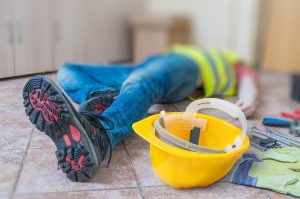Annually, more than 260,000 public and private industry workers miss 1 or more days of work due to injuries from falls. About 800 falls result in death each year. The construction industry typically experiences the highest frequency of fall-related deaths, while health care, wholesale, and retail businesses see the highest numbers of nonfatal fall injuries.

The financial burden is enormous, with the cost of fall injuries estimated at $70 billion annually, says the National Institute for Occupational Safety and Health (NIOSH). Travelers, a leading insurance provider, says there’s a common misconception that slip and fall injuries “just happen” and that, as a result, there’s little that can be done to prevent them. But that’s not the case.
The first step in preventing STFs is to understand what locations within your facility present the greatest potential for danger. Look for hazards such as:
- Slippery surfaces like gloss-finished tile and polished stone
- Holes or broken surfaces
- Uneven walking surfaces
- Poorly marked and/or lit walkways
- Wet surfaces caused by spills or poor drainage
- Slippery conditions due to mud, ice, or water during inclement weather
Fight these hazards with routine inspection and maintenance and action steps, including the following:
- Design entrances and walkways to accommodate foot traffic through your business.
- Conduct periodic walk-through surveys of the premises to help ensure your property is relatively free of risk.
- Provide adequate lighting for all walkways.
- Maintain all flooring surfaces at all times.
- Use slip-resistant floor treatments, especially in areas that may get wet.
- Apply floor treatments to manufacturer’s instructions.
- Use “wet floor” signage.
- Schedule maintenance of floor surfaces when foot traffic is low.
- Keep spill cleanup supplies accessible.
- Make sure entry areas are properly maintained and that any mats are secured to the floor.
- Promptly investigate any incidents and document findings.
Standing Up to Falls
Fall prevention expert Woody Dwyer is second vice president of workers’ compensation for Travelers Insurance–Risk Control. He organizes falls into three categories—indoor, outdoor, and those related to changes in level.
He urges employers to periodically assess the workplace to identify trip hazards, especially at the change of seasons. In the fall, for example, be sure to eliminate piles of wet, slippery leaves. In all seasons, it’s important to assess lighting, both inside and outside of your buildings, for sources of shadow, especially in darker spaces like parking lots.
Safety professionals or committee members should observe employees periodically to watch how they work. If you find people taking shortcuts from one building to another, consider paving the area to create a safer walkway and reduce hazards from walking through brush and grass.
Dwyer also reminds employers to pay attention to the risks associated with workers walking while using their phones. Check your policy and, if necessary, amend it to address this serious distraction hazard.
Look out, as well, for changing hazards. For example, a food manufacturing facility might produce a “wetter” product one day, and a dryer product the next day. The wetter process would yield more liquid runoff and a better chance for slips or falls. The key is to build awareness through communication—for example, during a preshift huddle or via text message.
Attitude is another big factor in falls. Dean McKenzie is director of OSHA’s directorate of construction. He notes that resistance to change is one of the chief obstacles in getting crew members to comply with safety rules. McKenzie, who spent 35 years in construction before joining OSHA, remembers macho laborers who would challenge one another with comments like, “If you can’t walk that beam without protection, you’re not an iron worker yet.” The good news is that such attitudes are changing, but it’s a cultural shift that will take time.
Finances are another motivation for employers. Consider that the cost of a good safety harness is around $500, while the cost of a serious injury can top $100,000. McKenzie says employers should not hesitate to share facts about the personal and financial cost of falls with employees. Use the facts to make an impact, build awareness and, ultimately change behavior.
